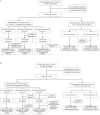Immunogenicity and safety of a recombinant fusion protein vaccine (V-01) against coronavirus disease 2019 in healthy adults: a randomized, double-blind, placebo-controlled, phase II trial
- PMID: 34310400
- PMCID: PMC8382383
- DOI: 10.1097/CM9.0000000000001702
Immunogenicity and safety of a recombinant fusion protein vaccine (V-01) against coronavirus disease 2019 in healthy adults: a randomized, double-blind, placebo-controlled, phase II trial
Abstract
Background: Innovative coronavirus disease 2019 (COVID-19) vaccines, with elevated global manufacturing capacity, enhanced safety and efficacy, simplified dosing regimens, and distribution that is less cold chain-dependent, are still global imperatives for tackling the ongoing pandemic. A previous phase I trial indicated that the recombinant COVID-19 vaccine (V-01), which contains a fusion protein (IFN-PADRE-RBD-Fc dimer) as its antigen, is safe and well tolerated, capable of inducing rapid and robust immune responses, and warranted further testing in additional clinical trials. Herein, we aimed to assess the immunogenicity and safety of V-01, providing rationales of appropriate dose regimen for further efficacy study.
Methods: A randomized, double-blind, placebo-controlled phase II clinical trial was initiated at the Gaozhou Municipal Centre for Disease Control and Prevention (Guangdong, China) in March 2021. Both younger (n = 440; 18-59 years of age) and older (n = 440; ≥60 years of age) adult participants in this trial were sequentially recruited into two distinct groups: two-dose regimen group in which participants were randomized either to follow a 10 or 25 μg of V-01 or placebo given intramuscularly 21 days apart (allocation ratio, 3:3:1, n = 120, 120, 40 for each regimen, respectively), or one-dose regimen groups in which participants were randomized either to receive a single injection of 50 μg of V-01 or placebo (allocation ratio, 3:1, n = 120, 40, respectively). The primary immunogenicity endpoints were the geometric mean titers of neutralizing antibodies against live severe acute respiratory syndrome coronavirus 2, and specific binding antibodies to the receptor binding domain (RBD). The primary safety endpoint evaluation was the frequencies and percentages of overall adverse events (AEs) within 30 days after full immunization.
Results: V-01 provoked substantial immune responses in the two-dose group, achieving encouragingly high titers of neutralizing antibody and anti-RBD immunoglobulin, which peaked at day 35 (161.9 [95% confidence interval [CI]: 133.3-196.7] and 149.3 [95%CI: 123.9-179.9] in 10 and 25 μg V-01 group of younger adults, respectively; 111.6 [95%CI: 89.6-139.1] and 111.1 [95%CI: 89.2-138.4] in 10 and 25 μg V-01 group of older adults, respectively), and remained high at day 49 after a day-21 second dose; these levels significantly exceed those in convalescent serum from symptomatic COVID-19 patients (53.6, 95%CI: 31.3-91.7). Our preliminary data show that V-01 is safe and well tolerated, with reactogenicity predominantly being absent or mild in severity and only one vaccine-related grade 3 or worse AE being observed within 30 days. The older adult participants demonstrated a more favorable safety profile compared with those in the younger adult group: with AEs percentages of 19.2%, 25.8%, 17.5% in older adults vs. 34.2%, 23.3%, 26.7% in younger adults at the 10, 25 μg V-01 two-dose group, and 50 μg V-01 one-dose group, respectively.
Conclusions: The vaccine candidate V-01 appears to be safe and immunogenic. The preliminary findings support the advancement of the two-dose, 10 μg V-01 regimen to a phase III trial for a large-scale population-based evaluation of safety and efficacy.
Trial registration: http://www.chictr.org.cn/index.aspx (No. ChiCTR2100045107, http://www.chictr.org.cn/showproj.aspx?proj=124702).
Copyright © 2021 The Chinese Medical Association, produced by Wolters Kluwer, Inc. under the CC-BY-NC-ND license.
Conflict of interest statement
Bo Wang and Zhong-Hui Xu are the employees of Livzon Bio Inc., China. All other authors declare no competing interests.
Figures



References
-
- Planas D, Bruel T, Grzelak L, Guivel-Benhassine F, Staropoli I, Porrot F, et al. . Sensitivity of infectious SARS-CoV-2 B.1.1.7 and B.1.351 variants to neutralizing antibodies. Nat Med 2021; 27:917–924. doi: 10.1038/s41591-021-01318-5. - PubMed
-
- Yadav PD, Sapkal GN, Abraham P, Ella R, Deshpande G, Patil DY, et al. . Neutralization of variant under investigation B.1.617 with sera of BBV152 vaccinees. Clin Infect Dis 2021; doi: 10.1093/cid/ciab411. - PubMed
-
- Planas D, Veyer D, Baidaliuk A, Staropoli I, Guivel-Benhassine F, Rajah MM, et al. . Reduced sensitivity of infectious SARS-CoV-2 variant B.1.617.2 to monoclonal antibodies and sera from convalescent and vaccinated individuals. bioRxiv 2021; doi: 10.1101/2021.05.26.445838.
Publication types
MeSH terms
Substances
LinkOut - more resources
Full Text Sources
Other Literature Sources
Medical

